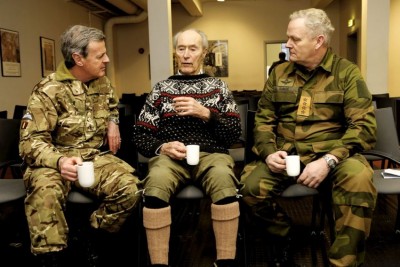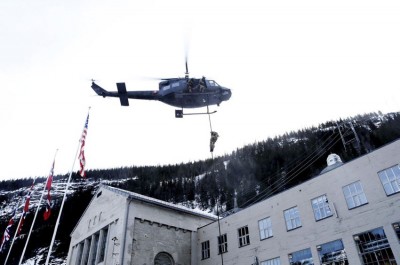Thursday marked the 70th anniversary of what some call Norway’s proudest moment during World War II, when Joachim Rønneberg and nine other Norwegian resistance fighters became the real-life “Heroes of Telemark” by sabotaging the heavy-water plant at Vemork. Rønneberg, the leader and last surviving member of the sabotage team, was back in Vemork this week to mark the event and reluctantly accept more thanks from a grateful nation.

He’s now 93 years old and has lived a relatively quiet life since the drama and bravery of February 28, 1943. That’s when the Norwegians made their way, in bitter winter cold, from the mountain plateau where they’d been hiding down the steep sides of the snow-covered valley where Vemork is located in Telemark County. A bridge over the canyon at the bottom of the valley was believed to be the only way into the Vemork power station that had been run by Norwegian industrial firm Norsk Hydro but taken over by Nazi forces after the German invasion in 1940.
The bridge was heavily guarded, so the saboteurs on skis defied the odds and snuck down the even steeper canyon walls, making it to the other side. From there they snuck along the railroad line to Rjukan, got through fencing and into the building, placed their explosives under 18 cylinders producing the heavy water (believed critical for Germany’s own plans for an atomic bomb) and retreated the same way. Not a shot was fired. Some members of the group got away by skiing to Sweden, others stayed to plan other operations against the occupiers in Norway.

Rønneberg, originally from Ålesund on Norway’s northwest coast, was only 21 years old when he fled the Nazis, made it to England and reported for duty in the resistance forces. He had no military experience but was a good skier, familiar with the mountains, keen on reading maps and had a burning desire to contribute to the war effort. He claims he wasn’t looking for adventure: “Norway wasn’t the same country it had been,” Rønneberg told newspaper Dagsavisen last week. “Folks were being arrested, shot and tortured.” He wanted to do something.
He quickly became part of the legendary Kompani Linge, made up of what today would be called elite troops or special forces. The Vemork operation was planned to prevent Nazi Germany from building a nuclear bomb and succeeded after Rønneberg and those he calls his “teammates” from England parachuted into Telemark, met up with resistance colleagues on the plateau and waited for the orders that came in February.

The names of Rønneberg, Jens-Anton Poulsson, Knut Haugland, Knut Haukelid, Claus Helberg, Kasper Idland, Fredrik Kayser, Arne Kjelstrup, Birger Strømsheim and Hans Storhaug are among those engraved on a monument to the critical sabotage operation at Vemork, which still regularly attracts visitors paying homage to their deeds. Rønning was the youngest and all the others have died. He’s remained a modest man who went on to work most of his life for state broadcaster NRK in Sunnmøre and he disliked the Hollywood movie Heroes of Telemark starring Kirk Douglas, calling it “the wild west.” In his recent interview with Dagsavisen, though, he said he realized he’s part of Norwegian history and that the film made their operation part of world history.
“I’ve felt there’s been too much focus on me and too little on those who really experienced something serious during the war,” said Rønneberg, who engaged himself in campaigns to help wounded veterans after the war.
Norway’s military hasn’t forgotten the contribution of Rønneberg and his fellow resistance fighters, returning to the scene with Rønneberg this week for a ceremony and demonstration of how special forces might undertake such a sabotage operation today. Norwegian Defense Chief Harald Sunde said the experience of the soldiers in Kompani Linge remain important for special operations today,
“The sabotage action 70 years ago could not have been more successful,” Sunde said. “They sabotaged without being seen, without firing a single shot and without a single life being lost.” Representatives of the US and British military were on hand at Vemork as well this week, still eager to speak with Rønneberg, and pay their respects.
“Freedom isn’t something to be taken for granted,” Rønneberg said during the military remembrance. “It’s not something we get for free. We had a lot of good luck.”
Views and News from Norway/Nina Berglund
Please support our news service. Readers in Norway can use our donor account. Our international readers can click on our “Donate” button:

